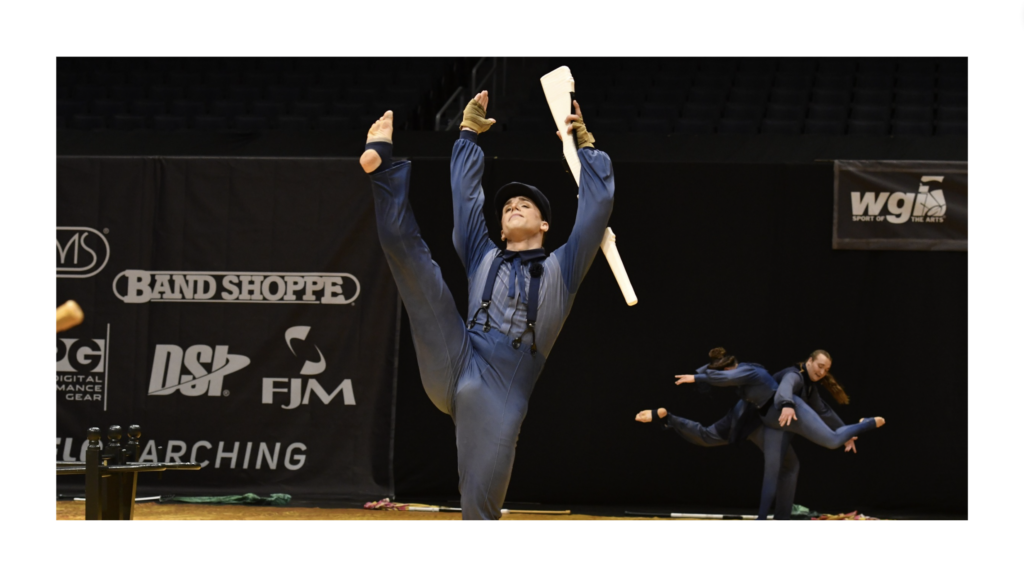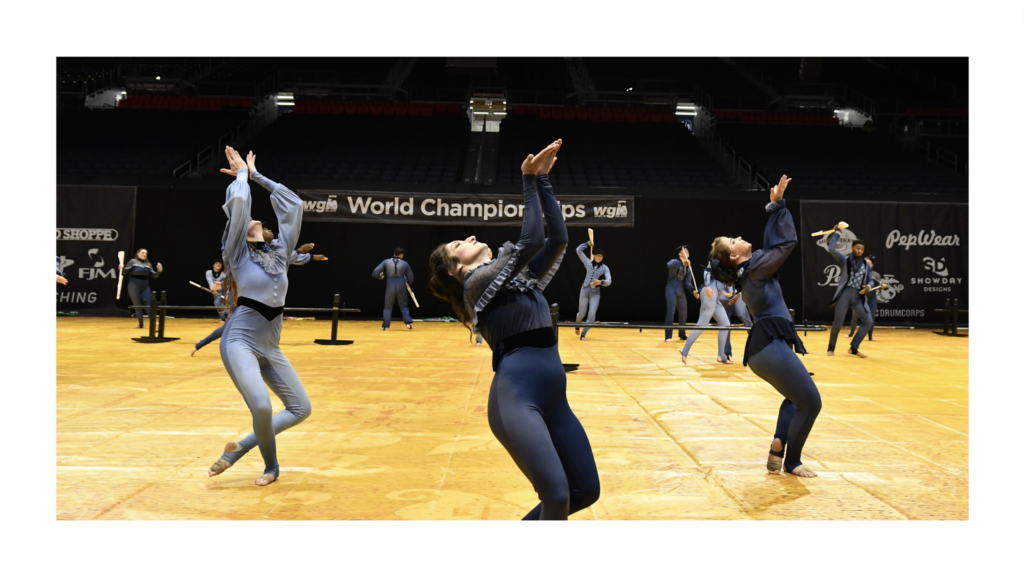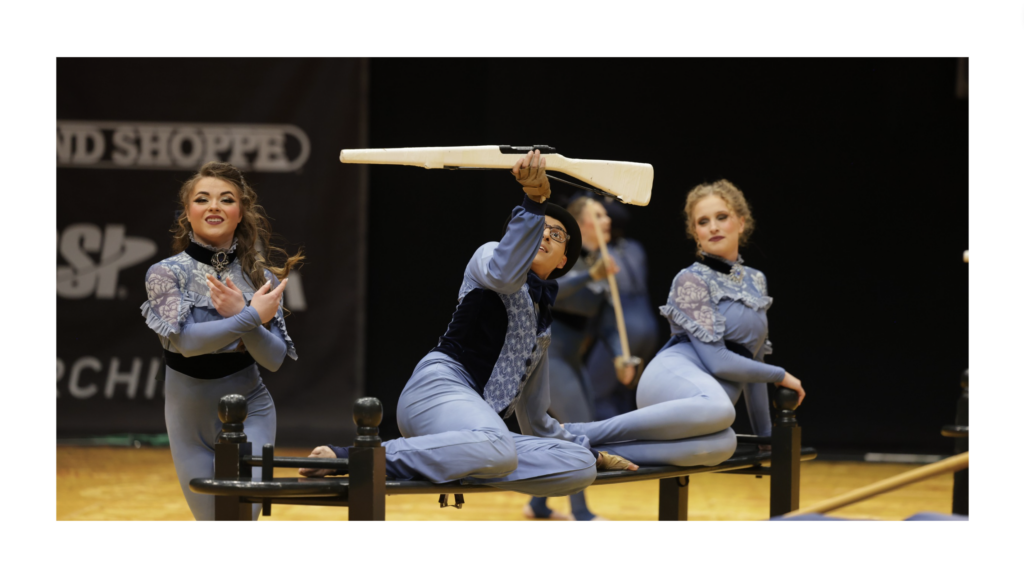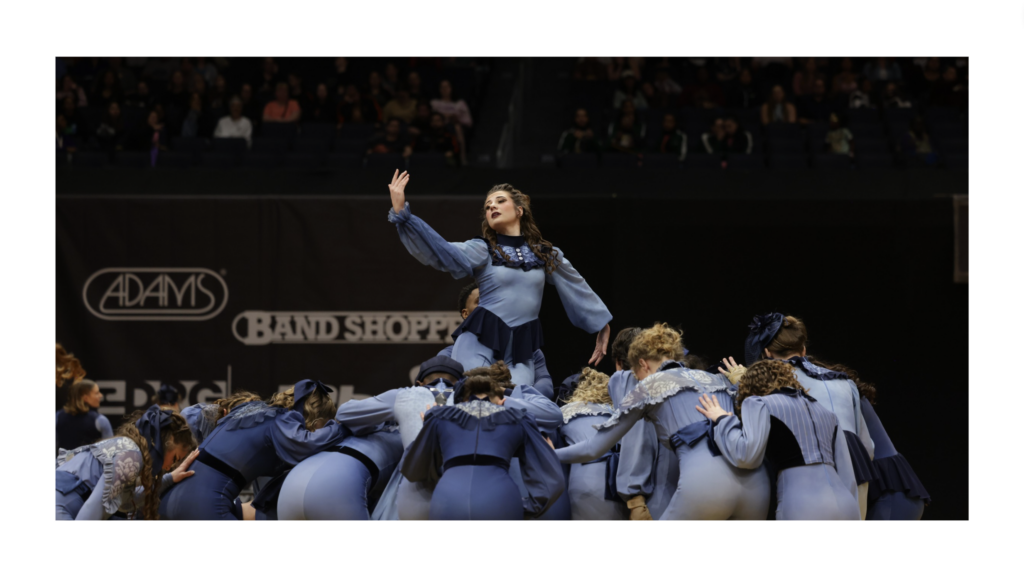By MJ Johnson
We caught up with Etude Winterguard Director Brian Franco-Winn to discuss Etude’s 2024 program, Those Days Are Gone. We discussed the feelings of loneliness that inspired the theme, the Edwardian influence on the costuming, and the joggling boards that occupied the performance floor.

The Story Behind “Those Days are Gone”
Brian credits Etude’s artistic director, Byron Valentine, with the show’s concept and artistic design. One little-known fact is that the idea was sparked by Brian’s wedding, which Byron officiated.
“Loneliness is something that we have experienced before, and it’s a concept that Byron has previously explored artistically,” Brian says. “What was different this time for him and for us was being at peace with that loneliness. There is sometimes a moment in life where you decide that you don’t want to be lonely, and you don’t want to be by yourself anymore.” Brian also notes that this can be considered a continuation of their 2020 program In the Company of Crows, which was another show about loneliness but told from a heavier perspective as opposed to 2024’s more optimistic and peaceful perspective.
The Edwardian Aesthetic and the Joggling Boards
Etude Winterguard had a distinct style this past season, from the incredibly detailed uniform design to the joggling boards used as props throughout the show. The inspiration for the costume came when learning about the composer’s inspiration when creating the original music. When composing All By Myself, Eric Carmen leaned heavily on Rachmaninoff’s Piano Concerto No. 2 in C minor, which was written around the turn of the 20th century. Brian tells us that the Edwardian era of fashion was where Byron’s inspiration for the costumes came from. “It was like taking a clip from that moment in time.”

Additionally, the program featured joggling boards, a staple of South Carolinian architecture. “That was again inspired by my wedding, which was held in Charleston, SC, and joggling boards are really prominent in the low country of South Carolina,” Brian says. Joggling boards can be found in downtown Charleston on porches or in front of restaurants and hotels.
“We were at this one particular restaurant, waiting for a table, and they had joggling boards out front,” Brian said. “We sat and rocked on them, joking about what they were. That’s when we dug a little deeper into what they meant and where they came from.”
Traditionally, joggling boards were used as a way for people who were courting to sit together. Couples would sit and, while having a conversation, they’d rock, bounce and joggle. The two individuals would slide closer together as the conversation continued, just by the design of the joggling board.
“This was another tangible representation of people starting apart and coming together,” Brian tells us. “It also provided a stage, a prop piece, a landing zone for us to have individuals by themselves, waiting for that other person to come and have a conversation or court with them. Joggling boards were around in that Edwardian time and are still around today. That’s kind of where that almost historical idea comes from. The idea of loneliness is nothing new. It’s nothing fresh or new or odd or bad. It’s something that’s been around as long as humanity has been around, and the desire to find another person, whether that’s friendship, love, or whatever it may be, is innate. We found that the show could still be really relatable even though the aesthetics were of that period 120 years ago.”
Etude heavily featured these joggling boards, with performers dancing on or around them, moving them around the floor, or simply sitting on them. “First and foremost,” Brian says. “We really explored just sitting on them and the ways we could sculpt using the joggling boards. Especially in the World class, we were pushing ourselves in ways that we could use the joggling boards to spin on or dance on or balance on and create elevation.”

While joggling boards rock side to side, they also bounce up and down. “It really challenged where your center of gravity was, so your center of gravity constantly changed depending on whether you were bouncing or swaying and rocking side to side.”
“From a staging standpoint, most benches are very sturdy and fixed. Any time we moved them, the rockers (as we called them) on either end slid and moved around. We had to be very meticulous with the way that the members picked the boards up, where the weight distribution was, and how they could transit from one place to the other. If we weren’t careful, the rockers could swing and hit their legs.”
Brian compared it to learning a new skill, job or piece of equipment. The members had to learn these benches and the tendencies of how they moved so that when they did maneuver around the floor with them, it looked as natural and coordinated as possible.
Memorable Moments and Looking Forward
When asked about a memorable moment in the 2024 season, Brian talked about his favorite part of the show. “The end of part 2, the resolution there, and the beginning of our part 3,” he says. “The full cast has moved the boards into this big diagonal down the floor where they’re all seated on the benches and all watching one member move by himself, almost searching for that partnership while there is a duet of dancers sitting on the opposite side of the floor together with their backs to the audience. That moment was always really special to me.”
“I think one thing I really connected with was that moment. I felt like that was super representative of what Etude is. There’s this one member out on the floor looking for what they want or need while the rest of the guard is behind them leaning in, almost like they are supporting him or cheering him on from behind. That’s something that’s always made Etude an extraordinary place. How it may just be one person, but the entire color guard is behind you, really interested and invested in you and what you need and what you’re striving for.”

When reflecting on the 2024 season, Brian highlights the impact of the design team and amazing membership. “When we finished last season, and we were looking forward to the next season, one thing that was really important to the entire design team was that we found our way back to presenting something beautiful and joyous in the color guard arena. We feel like we found a home in that aesthetic years ago and we really wanted to lean into that part of our identity. Additionally, this show was all the more special because of the cast. We have an amazing design team and an amazing technical staff, but the membership this year was really special in the way that they bought into the show concept and the way they invested in each other and the Etude family as a whole. As special as the 2024 season was, it would not have been the same with a different cast. I’m just grateful to have such wonderful people in the organization helping make beautiful art.”
Looking forward, Brian is most excited to be back in the gym with Etude. He wants to continue building on what they created this year and push the organization artistically. “I’m excited to see how we can improve what we’ve built and expand on our cast’s success.”
About the Author:
Madison Johnson graduated from the University of North Carolina at Charlotte with a BA in English Language and Digital Technologies with a concentration in Technical Writing. She currently works as a copywriter for a Software as a Service company in Charlotte, NC. She was a member of Étude Winter guard for five years from 2015-2019.

